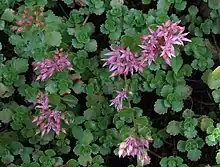| Phedimus | |
|---|---|
 | |
| Phedimus spurius | |
| Scientific classification | |
| Kingdom: | Plantae |
| Clade: | Tracheophytes |
| Clade: | Angiosperms |
| Clade: | Eudicots |
| Order: | Saxifragales |
| Family: | Crassulaceae |
| Subfamily: | Sempervivoideae |
| Tribe: | Umbiliceae |
| Genus: | Phedimus Raf. |
| Type species | |
| Phedimus stellatus[1] | |
| Subgenera | |
| |
Phedimus is a genus of the succulent family Crassulaceae (stonecrop family), with about 18 species, distributed in eastern Europe and Asia. The genus is described with two subgenera, but one of these is also recognized as a separate genus, Aizopsis. Phedimus kamtschaticus (syn. Sedum kamtschaticum) is widely grown as an ornamental ground cover and has gained the Royal Horticultural Society's Award of Garden Merit.[2]
Description
Species are perennial or rarely annual herbs, usually glabrous stems, sometimes woody at base, from thin woody rhizome. Leaves decussate or alternate, with narrow base, and several hydathodes on lower face along margins. The flowering branches are erect or descending, with dense inflorescences exhibiting many flowered terminal pleiochasia (several buds come out at the same time). Flowers 4-7 parts, sepals usually unequal, petals free, usually spreading. The fruits are follicles, usually spreading and seeds costate-papillate (incompletely connate), but multipapillate in Phedimus selskianus.[3]
When treated as Phedimus sensu lato, i.e. including Aizopsis, subgenus Phedimus (Phedimus sensu stricto) has creeping and rooting stems, flowers white, pink, red or purplish and chromosome numbers x=5,6,7, while subgenus Aizoon has annual shoots often woody at base, emerging from woody rhizomes, flowers yellow, orange or reddish and x=8.[3]
Taxonomy
Phedimus is a genus in the family Crassulaceae, subfamily Sempervivoideae, tribe Umbiliceae, together with three other genera. It was segregated from the very large cosmopolitan and polyphyletic genus, Sedum, where it was variously considered a section or subgenus.[4] Within the tribe it is a sister group to Aizopsis. There, it is distinguished by flower colouration (pink or white flowers compared to the yellow flowers of Aizopsis), floral morphology, distribution (Eurasia vs. Asia) and chromosome numbers (x=14 vs. 16). Some authors include Aizopsis as a subgenus:[1][3]
- Phedimus subgenus Phedimus c. 5 species
- Phedimus subgenus Aizoon c. 13 species
Distribution
Subgenus Phedimus Mediterranean to Caucasus. Subgenus Aizoon China, Japan, Korea and central Siberia.[3]
References
- 1 2 Gontcharova et al 2006.
- ↑ "Sedum kamtschaticum orange stonecrop". The Royal Horticultural Society. 2021. Retrieved 22 June 2021.
- 1 2 3 4 Thiede & Eggli 2007.
- ↑ Ohba et al 2000.
Bibliography
- Thiede, J; Eggli, U (2007). "Crassulaceae". In Kubitzki, Klaus (ed.). Berberidopsidales, Buxales, Crossosomatales, Fabales p.p., Geraniales, Gunnerales, Myrtales p.p., Proteales, Saxifragales, Vitales, Zygophyllales, Clusiaceae Alliance, Passifloraceae Alliance, Dilleniaceae, Huaceae, Picramniaceae, Sabiaceae. pp. 83–119. ISBN 978-3540322146. (full text at ResearchGate)
- Gontcharova, S. B.; Artyukova, E. V.; Gontcharov, A. A. (June 2006). "Phylogenetic relationships among members of the subfamily Sedoideae (Crassulaceae) inferred from the ITS region sequences of nuclear rDNA" (PDF). Russian Journal of Genetics. 42 (6): 654–661. doi:10.1134/S102279540606010X. S2CID 33249840.
- Grulich, Vit (1984). "Generic division of Sedoideae in Europe and the adjacent regions" (PDF). Preslia. 56: 29–45.
- Ohba, Hideaki; Bartholomew, Bruce M.; Turland, Nicholas J.; Kunjun, Fu (2000). "New Combinations in Phedimus (Crassulaceae)". Novon. 10 (4): 400–402. doi:10.2307/3392995. JSTOR 3392995.